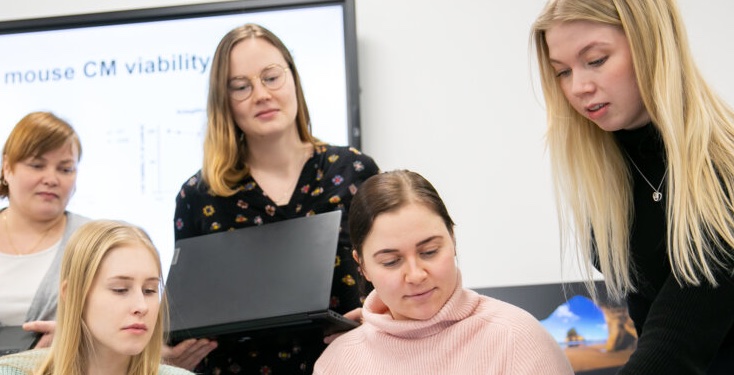Turun kauppakorkeakoulun tohtoriohjelmaan hakeneiden tutkimussuunnitelmien turnitointiin tarkoitettu kurssialue.
- Teacher
Jenni Gray
Turun kauppakorkeakoulun tohtoriohjelmaan hakeneiden tutkimussuunnitelmien turnitointiin tarkoitettu kurssialue.
Turun yliopiston luovan kirjoittamisen perusopintojen draama 1 opintojakso Omnia-opistossa, syksy 2023.

Objectives
Student learns to describe and understand the purpose of the different phases of the drug discovery and development process and discuss particular aspects of each stage of the process. Student can critically evaluate and select appropriate research methods to elucidate the pharmacological and pharmaceutical properties of drug molecules as well as to assess the toxicological and safety profiles of drug candidates during the various stages of non-clinical and clinical drug development. Furthermore, student understands the differences in drug development processes between "conventional" small molecule drugs, biologicals, and advanced therapy drugs, as well as biosimilars and generic drugs, which originate from differences in chemical, biological, and pharmacological properties and regulatory requirements. In addition, students can explain the role of intellectual property rights (IPR) in drug development and how this is reflected in the strategies of drug companies. Student understands the ethical guidelines that regulate the use of laboratory animals in research and clinical investigations. Student improves their skills in communication, scientific presenting, and team work by preparing presentations for Journal Clubs and podcasts as well as networking with external experts.

Participation in joint proseminars, mid-phase check-out meeting and MSc Thesis-seminars with peer MSc students.
Turnitin check for MSc Theses
Objectives
The essential aim of the course is that students understand and are able to describe the role of regulatory authorities in the drug development and approval processes and that they know the legal framework that regulates the field.
The specific aims of the course are that students are able to differentiate the general outline of the procedures applied to marketing authorization applications (MAA) in the EU area and in the USA, and are prepared to discuss and assess the actions executed by the main regulatory agencies (EMA and FDA). In addition, students will be able to describe how the different sections of MAAs are organized according to the common technical document (CTD) format, and how data are presented to demonstrate the pharmaceutical quality, efficacy, and safety of a new drug. Furthermore, students will understand and explain the principal methods used in pharmacovigilance, how the safety data of drugs that are already on the market are collected, and how toxicological and safety studies, required by the regulatory bodies for a new drug molecule, are designed and analyzed.
The general aims of the course are to stimulate and support scientific thinking, improve written communication skills, and introduce the basics of the peer-review process.
Objectives
Student knows how to write a research plan, conduct hands-on research at laboratory, analyse results obtained, and interpret results and write a scientific report. Student is able to do independent research work and reporting the area of drug discovery and development. Student can analyse and interpret relevant scientific literature and publications. Student masters their field of science, understands the research methodology and applies relevant methods to the project. Student can compare own results to the scientific literature and expand the current knowledge in the field.
Student masters scientific thinking and presenting new research data to the scientific community. Student understands their role in the research community and can justify and explain own results to peer scientists. Furthermore, students learn to communicate to other members of the research group and to different audience, like peer students, scientific and lay audience, orally, graphically and with written text. Student understands and learns to recognise plagiarism and scientific fraud.
This course has a strong focus on working life skills, professional life relevance and creative problem solving. Students learn to work in a research group and give feedback to peers as well as receive feedback from peers and experts in the area. Student recognises the time and resource limits of a scientific a research project and can adjust the actions accordingly.
This Moodle page contains various necessary information and materials for the doctoral students of the Marketing discipline.
Undergraduate course on Computer Architecture and Operating Systems.
The course is offered during August 28 - October 22, 2023.
Objectives
On the course, the student learns to evaluate the usability and user experience of products, to understand how they affect the success of products, and to design usable, enjoyable software products and services.
After the course, the student can:
- Evaluate the usability of products and services e.g. using usability heuristics
- Estimate usage needs and formulate design requirements
- Do traditional usability testing with test persons
- Understand quantitative analysis methods of usability and user experience
- Design user interfaces applying design tools
- Apply design patterns in UI design
- Understand the significance of accessibility in services
Students practice usability assessment skills of services using e.g. Nielsen's 10 heuristic rules. Common design tools are applied to user interface sketching in assignments.
The course strengthens the following working life skills: creativity, multi-professionalism, problem solving skills, information and communication technology skills, communication skills and cooperation and negotiation skills.
Objectives
On the course, the student learns to evaluate the usability and user experience of products, to understand how they affect the success of products, and to design usable, enjoyable software products and services.
After the course, the student can:
- Evaluate the usability of products and services e.g. using usability heuristics
- Estimate usage needs and formulate design requirements
- Do traditional usability testing with test persons
- Understand quantitative analysis methods of usability and user experience
- Design user interfaces applying design tools
- Apply design patterns in UI design
- Understand the significance of accessibility in services
Students practice usability assessment skills of services using e.g. Nielsen's 10 heuristic rules. Common design tools are applied to user interface sketching in assignments.
The course strengthens the following working life skills: creativity, multi-professionalism, problem solving skills, information and communication technology skills, communication skills and cooperation and negotiation skills.
Objectives
The course teaches students how to apply software design principles, design patterns, and architectural styles effectively, and document and evaluate architectures for large software systems. The student learns to:
- understand the theoretical aspects of design patterns and architectural styles
- apply design patterns and architectural styles in practice
- follow the recommended software design principles and avoid design smells
- design, document and evaluate architectures for large distributed systems
- explain the stakeholder forces and central quality attributes affecting the architecture
The course additionally introduces students to practical tools and methods for software design and documentation, such as model-driven development tools and the 4+1 architectural view model. The course strengthens the following working life skills: presentation skills, creativity, multi-professionalism, problem solving skills, project management, information and communication technology skills, communication skills and cooperation and negotiation skills.
Machine learning and AI approaches are discussed in the context of health and biosignal data. Machine learning models suitable for different data types are reviewed. The methods learned during the course are applied in practice on different data sets, such as Electrocardiogram (ECG) and Seismocardiogram (SCG) signals, to concretize the benefits as well as limitations of the applied approaches.
Objectives
At the course students adapt their theoretical knowledge to implement a working solution to a real-life challenge.
After the course students
- can plan and manage team work extending over several months and connect their own work with team deliverables
- recognize the roles and responsibilities of members in a project team and potential challenges in team work
- know how to communicate topics of one's own discipline to stakeholders with diverse educational backgrounds.
- know from firsthand experience how a complex and initially ill-defined problem is approached and solved through dividing work into phases with their own sub goals, milestones and deliverables
- can analyze and communicate the progress and performance of the project to project stakeholders
The course strengthens the following working life skills: presentation skills, creativity, multi-professionalism, problem solving skills, organizational and coordination skills, project management, information and communication technology skills, networking skills, communication skills and cooperation and negotiation skills.
Tavoitteet
Ohjelmistotuotanto (software engineering) käsittää monimutkaisten ohjelmistojärjestelmien suunnittelun, toteuttamisen ja ylläpidon liiketoimintaorganisaatiossa.
Kurssin suorittaneet opiskelijat tuntevat:
- ohjelmistotuotannon erityispiirteet ja haasteet insinöörialana
- ohjelmistokehitysprosessin kokonaisuuden ja projektityöskentelyn periaatteet
- asiakkaan roolin ohjelmiston suunnittelu- ja toteutusprosessissa
- ketterien työmenetelmien periaatteet ja osaavat soveltaa yhtä menetelmää
- jatkuvan kehittämisen(DevOps) toimintamallin ja sen menetelmien jatkuva integraatio(CI)/jatkuva toimitus(CD) periaatteet
Opintojakso vahvistaa seuraavia työelämävalmiuksia: esiintymistaidot, moniammatillisuus, organisointi- ja koordinointitaidot, projektinhallinta ja yhteistyö- ja neuvottelutaidot.

Kurssin suoritus: kirjallinen tentti tenttioikeuden saaneille, arvostelu 1-5.
Tenttioikeus:
Harjoitustehtävien maksimipisteistä on saatava yhteensä väh. 50,00 %, jotta voi osallistua tenttiin.
HUOM! Aikaisempien vuosien tenttioikeudet eivät ole voimassa vuoden 2025 tenteissä. Tenttioikeus on hankittava uudelleen osallistumalla kurssille ja hankkimalla harjoitustehtävistä riittävä suoritusprosentti.
Tenttimiskertoja
tulee olemaan kolme: yksi kurssin päätyttyä, yksi toukokuussa ja yksi
elokuussa. Kaksi viimeistä ovat Exam-tenttejä, jotka ovat
suoritettavissa 2 viikon ajan.
Ilmoittautuminen tentteihin laitoksen/yliopiston normaalien käytäntöjen mukaisesti, ellei muuta ilmoiteta.
Turun
yliopiston sähköisen tenttimisen yleisohje (1.2.2013) määrää, että
tentin voi varata aikaisintaan 30 vuorokautta ennen tentin suorittamista. Tämä ja moni muu asia selviää lukemalla sähköisen tenttimisen ohjeet opiskelijalle.
Kyberturvallisuusteknologian oppiaineen päätöksellä tämän kurssin sähköisten tenttimiskertojen tarkastamisaika katsotaan alkavaksi, kun suoritusmahdollisuus päättyy. 1.6.-31.8. välillä suoritettujen tenttien tulokset on ilmoitettava pääsääntöisesti 5.9. mennessä. Tarkastamisen alku voi viivästyä siinä tapauksessa, että sähköisen tenttimisen järjestelmässä on ollut häiriö, joka vaatii tentin pitämistä auki suunniteltua pidempään.
Kurssin sisältö ja tavoitteet: kts. opinto-opas.